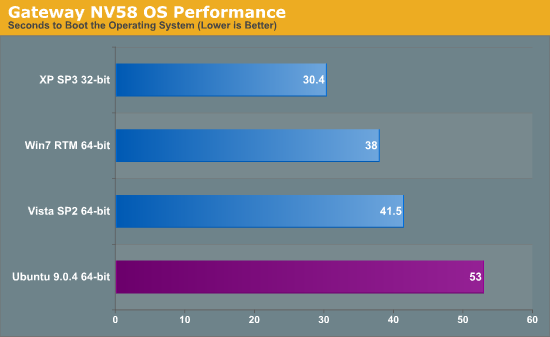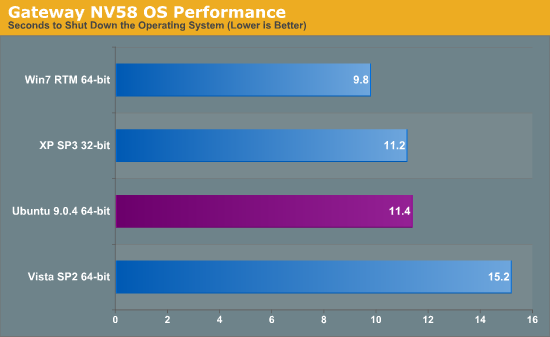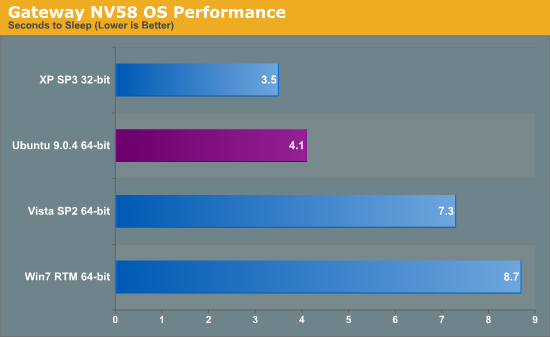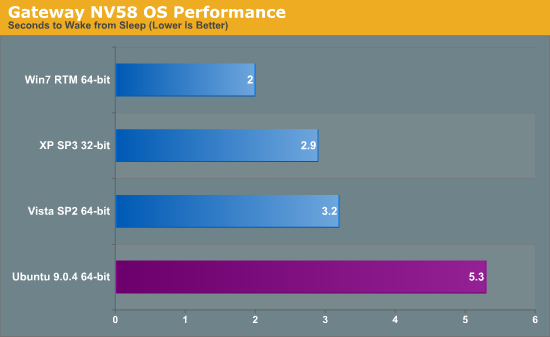Gateway NV58 (Intel) - OS Benchmarks
Wrapping up our look at OS performance on the NV58, we have our OS boot/shut down, hibernate/resume, and sleep/wake test results. As with the NV52, there was a fair amount of variability between test runs. We took the best result of numerous runs for each OS. Once more, note that Windows XP will have an advantage in the hibernate/resume testing because we are using a 32-bit OS (3GB addressable RAM) instead of a 64-bit OS (4GB addressable RAM). No OS wins - or loses - in every single category, but Windows XP and Win7 are usually near the top and Ubuntu and Vista are near the bottom.


XP loads the fastest once again, this time leading the competition by a larger margin than on the NV52. Windows 7 takes 25% longer to boot, Vista takes 36% longer, and Ubuntu is in last at 74% longer than XP. The GRUB delay is a large portion of the poor showing for Ubuntu, though; it would be very close to the Vista result without the extra ~10 seconds. Shut down times new Windows 7 into the lead, with XP and Ubuntu essentially tied at around 15% longer than Vista bringing up the rear taking 55% longer than Win7.


As expected, Windows XP leads in hibernate/resume times since it doesn't have to deal with as large of a hibernation file. Windows 7 trails XP in hibernate times by 30%, correlating very well with the difference in addressable memory. Ubuntu is in third place, requiring over three times as long to hibernate as XP (211% longer). The Vista result is the worst by far, taking 411% longer than XP. There's again the question of whether drivers are somehow at fault, but whatever the cause the NV58 took substantially longer to hibernate on Vista every single time. Resume times don't change the standings much, except Windows XP holds an even larger lead and takes less than half as long as the next closest competitor, Windows 7, which requires 102% more time. Windows Vista doesn't do as poorly in the resume times, though it still trails XP by 186%. Ubuntu is in last place taking just over four times as long to resume as XP, but again the 10 second GRUB penalty is at play.


Finally, in sleep times Windows XP again leads, this time followed by Ubuntu which is very close at only 17% longer. Vista takes 109% longer than XP and for once Windows 7 brings up the rear requiring 149% longer than XP to go to sleep. Interestingly, Win7 is the fastest when it comes to waking, requiring just 2 seconds. XP and Vista are 45% and 60% longer, but they're both only around three seconds. Ubuntu is last taking 165% longer than Windows 7, with a result of 5.3 seconds. Since we're dealing with such short times with sleep/wake cycles, the raw percentages and charts aren't nearly as meaningful. As mentioned before, Ubuntu and Win7 tend to be a little more consistent, whereas the best-case results for XP and Vista can be an order of magnitude faster than the worst-case results. If nothing else, Ubuntu is very consistent at going to sleep in around 5-10 seconds; Windows 7 sleep times range from just under 9 seconds up to around 30 seconds, and XP and Vista can take over a minute to go to sleep at times. The difference between 5 seconds and 10 seconds is somewhat annoying, but it's not a huge issue unless you're putting your system to sleep constantly. Occasional delays of over a minute on the other hand can be truly frustrating. For what it's worth, toss in an SSD and the sleep/wake times all appear to be far more consistent (though we didn't conduct in-depth testing on either of these notebooks with SSDs).










106 Comments
View All Comments
JarredWalton - Tuesday, September 22, 2009 - link
I'll look into powertop in a while. The issues with Windows really have a lot more to do with users than with the platform as a whole. My work PC has been running without any problems and without reinstalling the OS for over three years. My gaming system is in a similar state, and both have been through a few hardware upgrades, plus various driver and software installations.I don't run any "internet security suite" - be it McAfee, Norton, AVG, or anyone else. No AV, not even anti-malware (though I have scanned with Spybot S&D, Ad-Aware, and HiJackThis on occasion just to make sure). Why am I problem free? Because I know what I'm doing.
I think the same could be said of Linux users: they're mostly problem free because they know what they're doing, and they could be problem free in Windows if they wanted to put in a small amount of effort.
Put your average user in front of a Ubuntu installation -- or any Linux installation -- and they're going to be lost as soon as they want to do more than run email, OpenOffice, and surf the Internet. "But that's all you need!" Exactly: all you need and all you want are not the same. Windows makes it perhaps too easy for people that haven't got a clue to install programs and screw things up. LOL
Gamingphreek - Wednesday, September 23, 2009 - link
Honestly, all the configuration I suggested takes a few minutes at most. There is no compiling from source and no generating makefiles.As someone said earlier, Linux and Windows have different philosophies in terms of setup. Linux is an OS that depends on customization, at least SOME time needs to be put in configuring it.
Running powertop and writing a bash script takes a mere 5 minutes and can save >30 minutes of battery life in some cases. Enabling laptop mode is literally as simple as opening a file and changing the value from 0 to 1.
Updating the kernel, mesa, and graphics is literally 6 (2 for each -- 1 to add the repository and 1 to add the key) commands long and takes <5 minutes.
I understand this isn't an article on Linux, but these are not in depth tweaks and are things that anyone running Linux on a laptop will typically do.
Finally, you state that an average user would be lost in Linux. Honestly this is Anandtech - a very well known and reputable Tech based website. "Average users" typically do not venture here. Should you guys stop talking about Processor Architecture since people wont know what it means?
strikeback03 - Wednesday, September 23, 2009 - link
My father needed to move suddenly due to a job change, so I hooked him up with a computer I scavenged out of the trash at work. It had a XP license key on it, but thanks to their wonderful restrictions on what what disc can install what version I had no working installer for that key. So I threw Ubuntu on there, which does indeed do everything he needs (allow him to play with his investments and watch Hulu). He called last weekend asking where to find a driver for a printer that was not included by default, as the solution involved several lines of code he decided to just wait until I can walk him through setting up Remote Desktop and do it from here.Mattus27 - Monday, September 21, 2009 - link
I can't believe you tested using live dynamic websites, instead of just downloading a page and all its resources and running the test from disk. The drawbacks of that should have been fairly obvious.JarredWalton - Monday, September 21, 2009 - link
The problem is, there is a ton of JavaScript involved with any current website, and getting all of the content for an offline version isn't quite that simple. Go try it: download everything for www.AnandTech.com to your PC and then look at that file and compare it to how the site actually looks. Try that with Facebook, YouTube, Yahoo, MSN, CNN, HardOCP, FiringSquad, SlashDot, TechReport, etc. and you will find they all need tweaking to look anything approaching correct. (Well, maybe not every single one of them, but most will still end up with JavaScript files that load content from dynamic web servers.)Anyway, I wanted to test with "real" content and not some bogus artificial test that doesn't have anything to do with what real Internet sites are like (i.e. some of the MobileMark stuff has very questionable testing procedures). I wanted something I had control of that would still tax PCs like a real website. I've got some downloaded sites and I've been going through the HTML and modifying it to hopefully create a "static" page that I can host on our server and still have it work more or less correctly. That of course means another batch of testing, but so far it's looking good.
I debated scrapping the current article, but figured some would enjoy the read and the joys of testing multiple different OSes. Besides, this way I can get feedback on what other tests you might like to see.
gstrickler - Friday, September 25, 2009 - link
How about setting up a local caching web proxy and having all the machines connect via the proxy? It won't completely eliminate the variances of internet routing/throughput and connecting to live sites, but it should minimize them.As for Wi-Fi (and interference from your 2.4GHz phone), leave the Wi-Fi enabled and connected, but go ahead and connect the machines using Ethernet. The difference is drain of a modern Wi-Fi transceiver when transmitting/receiving vs "idle" is fairly small, so simply having it on and connected to the Wi-Fi access point (which will occasionally "talk" to each connected client") should be sufficient from a power draw standpoint while using Ethernet for the active network connection will be more reliable and won't be subject to the interference. You can put the Wi-Fi on a subnet that does not route to your proxy/firewall and/or give it no default gateway, which will ensure that all the real traffic in on Ethernet. You could add in an occasional Ping from each client to the WAP to ensure that the Wi-Fi card/connection stays active.
andrewaggb - Tuesday, September 22, 2009 - link
Well I certainly agree that testing dynamic websites at different times is not the way to go.I can also understand what you are saying about trying to download a site and all the related resources, I've tried in the past and the browser method doesn't work.
You'll probably need an external tool to download the site and all it's resources. A quick google search came up with this tool, http://www.surfoffline.com/">http://www.surfoffline.com/, I've never used it but it has a trial and it sounds like you can download entire websites and export them. Worth a shot anyways, there's probably a bunch of tools like this that "hopefully" work as advertised :-)
Lowly Worm - Monday, September 21, 2009 - link
".. we ran the same test under Windows Vista and a cheat significantly better battery life. "Heh.. DragonSpeak "a-cheating" on you? Makes for interesting phonetic typos.
JarredWalton - Monday, September 21, 2009 - link
Yup. Thanks for the correction - was supposed to be "achieved", naturally. :)lordmetroid - Monday, September 21, 2009 - link
The Linux distribution you tested while mainstream, maybe not as tailored to mobility as say the Moblin distribution by intel, though still in Beta, I would loved to have seen that distribution tested considering it is specially built with focus on mobile platforms.